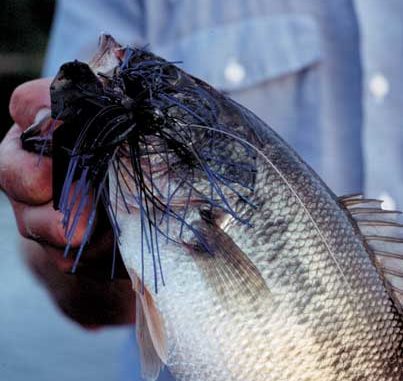
There are certainly a lot of different ways to catch bass in October, and one of my favorites is to swim a jig.
It’s a really good technique, because a jig is a big-fish bait, and you can expect to have a chance to catch a couple of fish that will weigh 5 pounds or better in a day’s time if you get on a good pattern. You just don’t catch that many little fish.
Swimming a jig is pretty much just what it sounds like. Instead of crawling it or hopping it across the bottom, you swim it with a steady retrieve. I like to swim a jig about the same speed that I slow-roll a spinnerbait.
I usually start by swimming it between 6 and 12 inches under the surface, but if I don’t get any bites that way, I’ll count it down and swim it a little deeper. That works because in the fall, you’ll often find bass that are suspended, not relating to any kind of cover on the bottom.
My favorite jig to swim is a 3/8-ounce Buckeye Mop Jig. I stick to basic jig colors: brown, black or black and blue. When I want to mess around with colors, I’ll change the color of the trailer I’m using, which is usually a Berkley Critter Crawler.
You can change colors much more easily by changing the color of the trailer, and you can give a jig all kinds of different looks. You can go with chartreuse or your typical brown/green pumpkin combination, and a lot of times, I’ll dip the tail in some chartreuse dye. If I’m looking for a darker silhouette, I’ll fish junebug, black or blue sapphire. Colors are more about what you’re comfortable with than anything else. They’re a confidence thing.
With bass on the move in the fall, following shad back into the creeks of most of our lakes in South Carolina, I’ll start the same way you would if you were going to fish a spinnerbait or a crankbait. I put the trolling motor down and fish. I’ll fish pockets, points, laydowns, docks. I seem to catch a lot of fish around docks this time of the year; they’ll either get on the posts on wooden docks, or they’ll get up under and around floating docks.
Anyway, you just start fishing, and when you get a few bites, you start working on a pattern. Bass pattern very well in the fall, and after just a few fish, you should be able to pinpoint where you’re going to find them on any given day.
Depending on what bass are doing, I’ll swim a jig on one of two rods. If I’m just casting it and swimming it back, I’ll use a 7-foot, medium-heavy action All-Star baitcasting rod with a Pfleuger Supreme reel spooled with 17-pound Trilene Maxx. If I find them hanging out in that thick bank grass we have in a lot of our lakes, I’ll go with a 40-pound braid like Spiderwire, because a jig tends to “grab” vegetation, and I can pull it loose easier with Spiderwire, which has virtually no stretch.
If I find that fish are up under piers or docks where I have to make sidearm or underhand casts to get the jig back to them, I’ll drop down to a 6-1/2-foot rod, but nothing else will change.
As I said earlier, I start by retrieving the jig just below the surface, almost where I can see it — the way a lot of people will fish a spinnerbait. If I don’t get any hits, I’ll start counting it down and fish it several feet below the surface. But I never, ever let it fall all the way to the bottom. Sometimes I’ll retrieve it the same speed I slow-roll a spinnerbait, sometimes a little faster.
I normally fish from mid-way back in a creek to all the way back. Most of our lakes have at least a handful of feeder creeks, and I will normally look for the one that’s got the best water flow. A lot of creeks don’t seem to have a lot of water flow — they really slow down during the summer. I try to find a creek that’s got at least some water flowing into it, and a little is better than none.
Although a lot of our lakes are starting to drop as they get to their winter drawdown levels, I don’t necessarily think you need a lot of current — just some water coming into a creek. Those are your better creeks. Sometimes, they may have some water coming in from a treatment plant of some kind, that that’s a positive for the baitfish.
Swimming a jig is only one of the techniques that a bass fisherman can use in the fall, but it’s kind of a different technique that will really work well, especially for big fish. I’ll always have at least one rod rigged to swim a jig every time I put my boat in in October.
The guy who taught me to swim a jig was a guy from North Carolina named Mike Seawright. He used to fish with Ronnie Tapp a lot, and he was the guy who gave me enough confidence in it to fish it a lot.
It’s a technique I dearly love.
Davy Hite is a 42-year-old native of Saluda who now lives in Ninety Six. He has fished professionally since 1993, winning the BASS Angler of the Year award in 1997 and 2002, the Bassmasters Classic in 1999 and the FLW Tour Champion-ship in 1998. He is sponsored by Triton boats, Evinrude outboards, All-Star rods, Pfleuger reels, Pure Fishing (Berkley), Owner hooks and Solar Bat sunglasses.




Be the first to comment